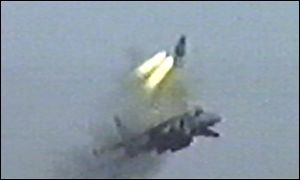No shit? Can't win 'em all. That's pretty cool. I figured it would work like a minigun.
I'll sit over here and color now.
I'll sit over here and color now.
I NEVER said to go DO THAT! I just said that it could be done, and that I know it was thrown around as a tactic by the Brits in the Falklands era. I know it's something I wouldn't do.
I know that you want to keep your energy up. I was not advocating any tactic, just saying that it does, in fact, exist, or at least was one that Harrier advocates threw out at one point in time. Don't put words in my mouth. I think I made it clear that I wasn't offering tactical advice, just saying that there is that capability.
Actually, Phrog is right. We do use it in ACM. It offers us some VERY unique advantages, especially considering we're at a couple of serious disadvantages. But, I'm not going into any more detail!
Aren't you on for SDO today?once again all you need to learn about everything is from flytpay
Does any gun work off bleed air? Considering the cyclic rate would change with power setting, I would think that would work poorly.
Phrog, you lost points on that one, it does actually run on bleed air. Hot gas reingestion, among other things, drives NATOPS limitations on min airspeed to fire.

You don't necessarily have to use water to land, unless your desired landing weight necessitates the extra performance/thrust that it provides. If water is required then it can become a limitation since you only have 90 seconds of it on board. Of course water doesn't begin to flow immediately in the decel and you may be light enough to hover without it by the time it's exhausted, so that doesn't mean you can only hover for 90 seconds. Ultimately NATOPS limits you to 5 minutes of continuous hover followed by an equal cooling period.

at least one perfectly good jet has been shelled out of thanks to that little imperative...
And yes, nozzles can be used for BFM but not everyone is a fan of it. More of a last ditch maneuver or maybe to tweak it over the top on a roller. Probably the most common usage of nozzles in flight is to control closure - joining on lead or a tanker, you can carry lots of smash early on and then kill it quickly. Just gotta remember to put 'em back aft, at least one perfectly good jet has been shelled out of thanks to that little imperative...
... at least two.
Best Regards,
Waldo
Not VIFFing, but case of hazards (to your career and aircraft) of Hovering near a beach
Not VIFFing, but case of hazards (to your career and aircraft) of Hovering near a beach
And for my next magical trick....
Uh, what the hell happened there?

Brit Harrier doing a hover stunt for an airshow circa 2002. Ejection was not part of the planned stunt.
